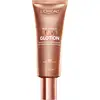What's inside
What's inside
 Key Ingredients
Key Ingredients

 Benefits
Benefits

 Concerns
Concerns

 Ingredients Side-by-side
Ingredients Side-by-side

Water
Skin ConditioningIsoamyl Laurate
EmollientDimethicone
EmollientCI 77400
Cosmetic ColorantHydroxyethyl Acrylate/Sodium Acryloyldimethyl Taurate Copolymer
Emulsion StabilisingGlycerin
HumectantOrbignya Oleifera Seed Oil
EmollientCI 77492
Cosmetic ColorantTheobroma Grandiflorum Seed Butter
Skin ConditioningSorbitan Isostearate
EmulsifyingPolysorbate 60
EmulsifyingSqualane
EmollientTocopherol
AntioxidantSilica
AbrasiveCitric Acid
BufferingSodium Citrate
BufferingPhenoxyethanol
PreservativeBenzyl Alcohol
PerfumingCI 77491
Cosmetic ColorantWater, Isoamyl Laurate, Dimethicone, CI 77400, Hydroxyethyl Acrylate/Sodium Acryloyldimethyl Taurate Copolymer, Glycerin, Orbignya Oleifera Seed Oil, CI 77492, Theobroma Grandiflorum Seed Butter, Sorbitan Isostearate, Polysorbate 60, Squalane, Tocopherol, Silica, Citric Acid, Sodium Citrate, Phenoxyethanol, Benzyl Alcohol, CI 77491
Water
Skin ConditioningGlycerin
HumectantCyclohexasiloxane
EmollientAlcohol Denat.
AntimicrobialSynthetic Fluorphlogopite
Butyrospermum Parkii Butter
Skin ConditioningDimethicone
EmollientAmmonium Polyacryloyldimethyl Taurate
Emulsion StabilisingPolyglyceryl-6 Distearate
EmulsifyingMica
Cosmetic ColorantCI 77891
Cosmetic ColorantPolysilicone-11
Phenoxyethanol
PreservativePentaerythrityl Tetraethylhexanoate
EmollientCI 77491
Cosmetic ColorantJojoba Esters
EmollientCapryloyl Salicylic Acid
ExfoliatingCaprylyl Glycol
EmollientPolyacrylamide
Boron Nitride
AbsorbentPolyglyceryl-3 Beeswax
EmulsifyingCetyl Alcohol
EmollientC13-14 Isoparaffin
EmollientAdenosine
Skin ConditioningDisodium EDTA
Laureth-7
EmulsifyingSodium Hydroxide
BufferingTin Oxide
AbrasiveCitric Acid
BufferingCeramide AP
Skin ConditioningWater, Glycerin, Cyclohexasiloxane, Alcohol Denat., Synthetic Fluorphlogopite, Butyrospermum Parkii Butter, Dimethicone, Ammonium Polyacryloyldimethyl Taurate, Polyglyceryl-6 Distearate, Mica, CI 77891, Polysilicone-11, Phenoxyethanol, Pentaerythrityl Tetraethylhexanoate, CI 77491, Jojoba Esters, Capryloyl Salicylic Acid, Caprylyl Glycol, Polyacrylamide, Boron Nitride, Polyglyceryl-3 Beeswax, Cetyl Alcohol, C13-14 Isoparaffin, Adenosine, Disodium EDTA, Laureth-7, Sodium Hydroxide, Tin Oxide, Citric Acid, Ceramide AP
 Reviews
Reviews

Ingredients Explained
These ingredients are found in both products.
Ingredients higher up in an ingredient list are typically present in a larger amount.
Ci 77491 is also hydrated iron III oxide. It's sole purpose is to give a red/pink hue to products.
Iron III oxides are classified as inorganic chemicals for coloring.
Synthetically created Ci 77491 is considered safer than those naturally found. This is because the synthetically created version may contain less impurities. Iron oxides are generally non-toxic and non-allergenic.
Learn more about CI 77491Citric Acid is an alpha hydroxy acid (AHA) naturally found in citrus fruits like oranges, lemons, and limes.
Like other AHAs, citric acid can exfoliate skin by breaking down the bonds that hold dead skin cells together. This helps reveal smoother and brighter skin underneath.
However, this exfoliating effect only happens at high concentrations (20%) which can be hard to find in cosmetic products.
Due to this, citric acid is usually included in small amounts as a pH adjuster. This helps keep products slightly more acidic and compatible with skin's natural pH.
In skincare formulas, citric acid can:
While it can provide some skin benefits, research shows lactic acid and glycolic acid are generally more effective and less irritating exfoliants.
Most citric acid used in skincare today is made by fermenting sugars (usually from molasses). This synthetic version is identical to the natural citrus form but easier to stabilize and use in formulations.
Read more about some other popular AHA's here:
Learn more about Citric AcidDimethicone is a type of synthetic silicone created from natural materials such as quartz.
What it does:
Dimethicone comes in different viscosities:
Depending on the viscosity, dimethicone has different properties.
Ingredients lists don't always show which type is used, so we recommend reaching out to the brand if you have questions about the viscosity.
This ingredient is unlikely to cause irritation because it does not get absorbed into skin. However, people with silicone allergies should be careful about using this ingredient.
Note: Dimethicone may contribute to pilling. This is because it is not oil or water soluble, so pilling may occur when layered with products. When mixed with heavy oils in a formula, the outcome is also quite greasy.
Learn more about DimethiconeGlycerin is already naturally found in your skin. It helps moisturize and protect your skin.
A study from 2016 found glycerin to be more effective as a humectant than AHAs and hyaluronic acid.
As a humectant, it helps the skin stay hydrated by pulling moisture to your skin. The low molecular weight of glycerin allows it to pull moisture into the deeper layers of your skin.
Hydrated skin improves your skin barrier; Your skin barrier helps protect against irritants and bacteria.
Glycerin has also been found to have antimicrobial and antiviral properties. Due to these properties, glycerin is often used in wound and burn treatments.
In cosmetics, glycerin is usually derived from plants such as soybean or palm. However, it can also be sourced from animals, such as tallow or animal fat.
This ingredient is organic, colorless, odorless, and non-toxic.
Glycerin is the name for this ingredient in American English. British English uses Glycerol/Glycerine.
Learn more about GlycerinPhenoxyethanol is a preservative that has germicide, antimicrobial, and aromatic properties. Studies show that phenoxyethanol can prevent microbial growth. By itself, it has a scent that is similar to that of a rose.
It's often used in formulations along with Caprylyl Glycol to preserve the shelf life of products.
Water. It's the most common cosmetic ingredient of all. You'll usually see it at the top of ingredient lists, meaning that it makes up the largest part of the product.
So why is it so popular? Water most often acts as a solvent - this means that it helps dissolve other ingredients into the formulation.
You'll also recognize water as that liquid we all need to stay alive. If you see this, drink a glass of water. Stay hydrated!
Learn more about Water